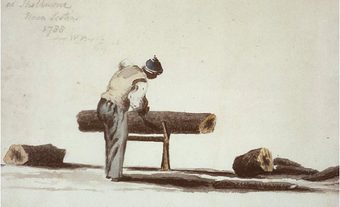The Canadian Centre for Architecture (CCA) is both a museum of architecture and a research institute. It is located in Shaughnessy Village, a neighbourhood in downtown Montreal. Internationally renowned, the CCA is the primary Canadian institute devoted to the study of architecture. It was founded in 1979 by architect Phyllis Lambert to raise public awareness of the importance of architecture in society and to encourage innovation and university research regarding architecture.
Background
Initiated by such groups as Sauvons Montréal and the Milton Park Citizens’ Committee, the roots of the CCA lie in the architectural conservation movement which started in Montreal in the late 1960s and continued throughout the 1970s. At the time, architect Phyllis Lambert was highly critical of the destruction of a number of Montreal areas. The city was cutting down trees to create parking spaces and transforming streets into “urban boulevards.” Entire neighbourhoods (such as Faubourg à m’lasse, Shaughnessy Village, the Square Mile and Little Burgundy) were demolished. Activist groups felt that too much of Montreal’s traditional architecture was being destroyed in the name of urban renewal and progress, making the city unliveable. In 1975, Phyllis Lambert participated in the founding of Heritage Montreal, an organization dedicated to the promotion and protection of the rich architectural heritage of the Greater Montreal area.
Design of the Canadian Centre for Architecture
In 1974, Phyllis Lambert purchased Shaughnessy House (originally consisting of two Second Empire-style residences built in 1874), thus saving it from demolition. Shaughnessy House was used as the core structure of the Canadian Centre for Architecture, the construction of which began in 1985. The Centre was opened to the public in 1989. Surrounding Shaughnessy House with a modern structure, the CCA building is shaped like the letter E. The complete restoration of Shaughnessy House returned it to its original splendour. The modern building is designed to emphasize the grandeur and architectural ornamentation of the old structure. It is very much in keeping with Montreal architecture (in particular, through the use of grey limestone). Other materials used include wood from Canadian maple trees and aluminum produced by the Alcan company, one of the CCA’s main donors. The CAA landscaping has restored a more residential appearance to a neighbourhood long marked by demolitions and the removal of many trees. The Melvin Charney sculpture garden located to south of the CCA, on the other side of René-Lévesque Boulevard (see also René Lévesque), includes a series of allegorical sculptures reminiscent of Montreal architecture.
In addition to large offices, the CCA includes exhibition space, a library, a theatre, a bookstore, and a study centre, all of which are located on top of a two-level basement containing the extensive collection of CCA artifacts.
Exhibitions
The CCA has a number of galleries and exhibition halls. It can thus hold a number of exhibitions at the same time or allocate the entire 12,000 square metre space to a single large exhibition.
The exhibitions draw on original research conducted at the CCA and are motivated by the desire to further advance the study of the role of architecture in society. In addition to preparing exhibitions in Montreal, the CCA collaborates with museums throughout the world exhibiting their own unique collections of artifacts, pictures, designs, models and other architecture-related media.
The CCA is renowned for its unique approach to exhibition design. With each new exhibition, it seeks to redefine how museum art is represented. The CCA works with architects and designers on a regular basis to create new exhibitions, seeing each one as an opportunity to redefine the character of the museum.
Collections
The CCA has one of the most extensive architectural collections in the world and includes objects which date to the Renaissance. This vast, internationally renowned collection includes all types of objects and documents related to the history of architecture. The CCA is home to the personal collections of distinguished architects such as Ernest Cormier, Peter Eisenman, Arthur Erickson, John Hejduk, Cedric Price, Aldo Rossi, and James Stirling, as well as of artist Gordon Matta-Clark. The CCA archives are often consulted by architects and academics throughout the world.
Publications
The mission of the CCA is to explore new ideas using various means. To this end, it publishes books and other works based on its exhibitions and research. These books are translated into many languages and are often published in collaboration with other institutions.
Public Activities
Guide interpreters provide guided tours of the CCA, exhibitions and sculpture garden. The CCA also offers educational activities to school groups and, on occasion, provides private guided tours. It is also possible to tour the Centre on one’s own, using an audio guide. Shaughnessy House is open to the public and offers courses and seminars. The library is open to the public by appointment. Several times a year, the CCA extends its hours of operation, such as during Montreal’s Nuit Blanche and for evening openings of new exhibitions.

 Share on Facebook
Share on Facebook Share on X
Share on X Share by Email
Share by Email Share on Google Classroom
Share on Google Classroom






